Most of us wouldn’t dream of trying to climb Mount Everest, and the brave few who do, generally do it once and then limp home to write a book about it.
There’s a good reason for this: climbing Mount Everest is so darn difficult.
Stairs are to dachshunds what Mount Everest is to people. This is an exaggeration, of course, but it’s not that far off the mark.
Imagine how high a staircase must look to a miniature doxie standing at the bottom, and how hard it must be to haul a long body up each step when you have such little legs.
It must be so darn difficult.
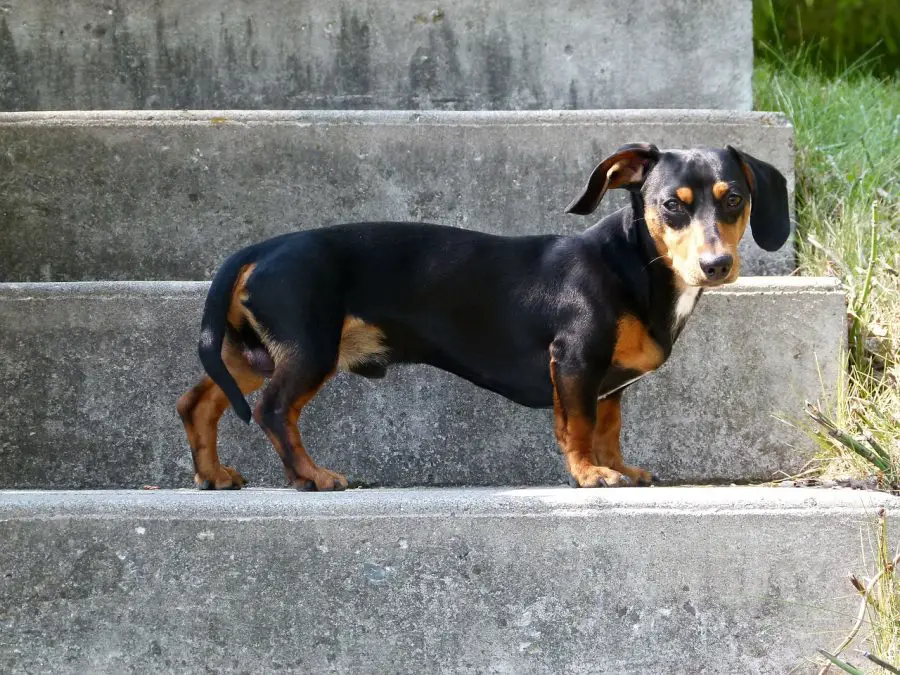
Dachshunds aren’t designed to run up and down stairs and, if they do it often enough, it can eventually lead to intervertebral disc disease (IVDD), a spinal injury common to doxies.
A little knowledge of what IVDD is and how to prevent it increases your dachshund’s chances of living a long and pain-free life.
What is Intervertebral Disc Disease (IVDD)?
About 25% of dachshunds get IVDD.
Just like people, doxies have discs filled with a jelly-like substance between the vertebrae in their spines. These discs act as cushions to prevent damage to the vertebrae.
IVDD is a condition where the discs, instead of remaining soft and jelly-like, harden and then burst.
When a disc bursts the jelly enters the spinal canal and compresses the spinal cord. It’s an excruciatingly painful condition and can cause paralysis.
Climbing up and down stairs, on and off furniture, and being overweight, are some of the causes of discs hardening and bursting.
Symptoms of IVDD
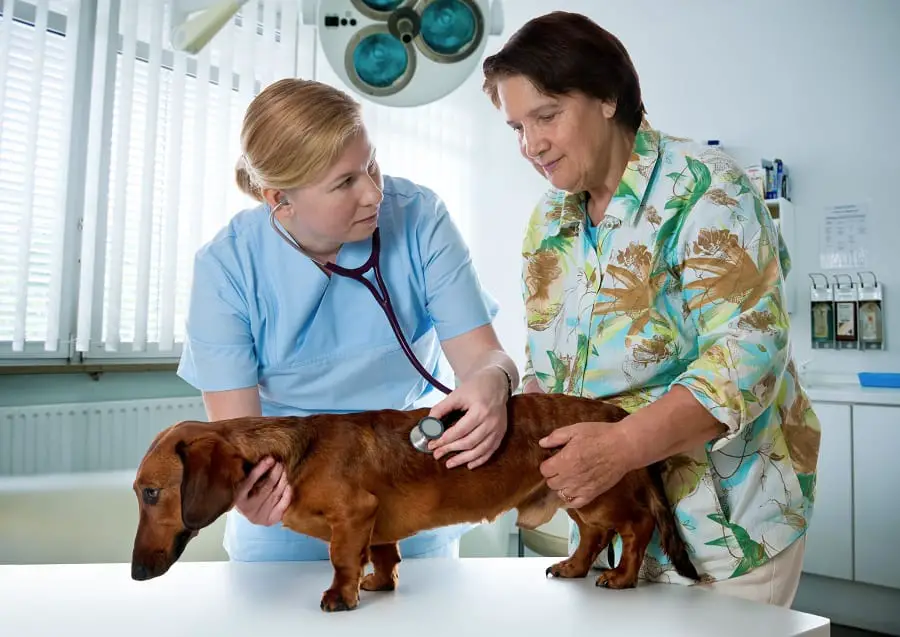
If your doxie is showing signs of pain, like whining and whimpering, it may be an early sign of IVDD.
Other early signs are not wanting to move and not wanting to be picked up. Sometimes an arched back or a head held high is a sign that a doxie has a spinal injury.
A dachshund who drags his back legs, or can’t move at all, is a sign that the IVDD is close to being irreversible and needs immediate medical attention.
In any case, the sooner you get your dachshund to the vet the better the chances are for a full recovery.
Don’t delay.
IVDD Surgery
As difficult as it is to think about surgery for your beloved dachshund, it’s the only option if your doxie is dragging his back legs or is unable to move at all.
Most importantly, if your doxie can’t move at all, the surgery must be done within 24 hours for it to be successful.
The good news is that if you get your doxie to the vet quickly, and the surgery is done by a trained neurologist, the success rate is very high at 96%.
The surgery removes the jelly from the spinal canal and solves the problem.
The neurologist may also remove jelly from unburst discs to prevent the problem from happening again.
Physical therapy begins immediately after surgery, but the full healing period is only slightly less than for non-surgical treatment: 6 to 8 weeks.
Non-surgical IVDD Treatment
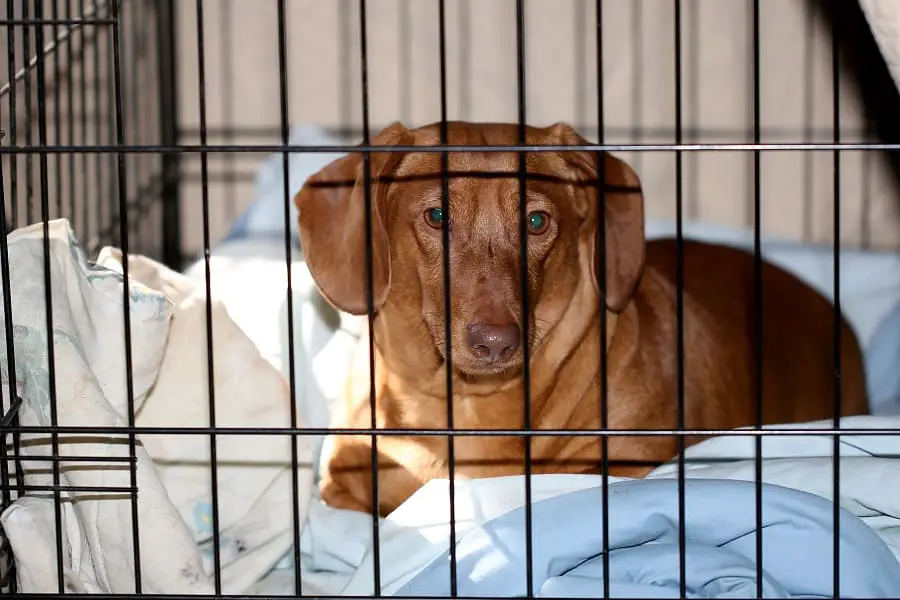
Non-surgical treatment can be successful if IVDD is in its early stages, but it’s not an option if it’s progressed to the stage where your doxie is dragging his back legs or can’t move at all.
Non-surgical treatment also has a long recovery time: it involves weeks of rest where your doxie is confined to a crate with only very little physical activity.
This is a problem in itself as the muscles that help to keep the back strong weaken due to a lack of exercise and can take months to strengthen again.
Your vet may recommend acupuncture and laser therapy during this period.
When your doxie has made some progress, physical therapy is essential.
Slowly and carefully, you may be able to start taking your dachshund for short walks, or to hydrotherapy.
Your vet may also suggest a wobble board to build up your doxie’s strength again, especially for those critical back muscles.
Non-surgical treatment takes a minimum of 2 months for your doxie to be functional again.
It’s not a permanent cure, and there’s about a 50% chance that it will reoccur.
An Ounce of Prevention is Worth a Pound of Cure
As we now know, IVDD is extremely painful for our doxies, and the road to recovery is a long and difficult one.
Also, it’s so expensive that many people can’t afford it and opt for euthanasia instead.
It’s much better to do everything we can to keep our dachshunds from getting IVDD in the first place.
No stairs!
Either install a baby gate so that your doxie doesn’t have the choice of running up and down stairs, or put a ramp next to the stairs so that your dachshund is free to use the whole house but doesn’t risk injuring his spine.
Even if you live in a one-level home, ramps should be built or installed next to stairs leading from the back or front yards into the house.
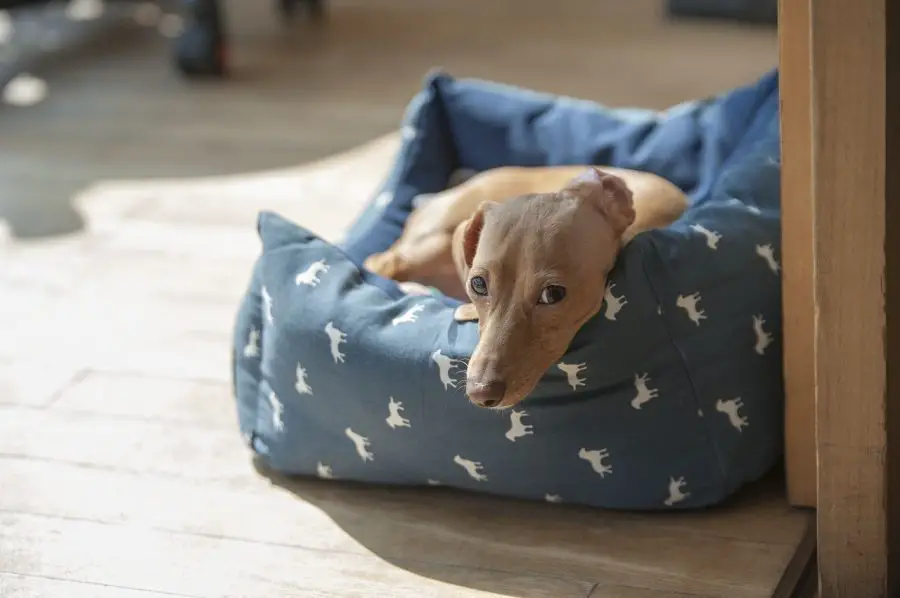
While you’re at it, if your doxie jumps on and off furniture to be close to you, you may want to consider installing a ramp or two next to the couch and your bed.
Jumping causes the same stress to discs that climbing up and down stairs does and can also eventually lead to IVDD.
You’ll probably never be able to completely stop your dachshund from climbing stairs or jumping on and off furniture.
This is nothing to worry about if it happens every now and then and isn’t a regular and repetitive exercise.
Training Your Doxie to Use Ramps instead of Stairs
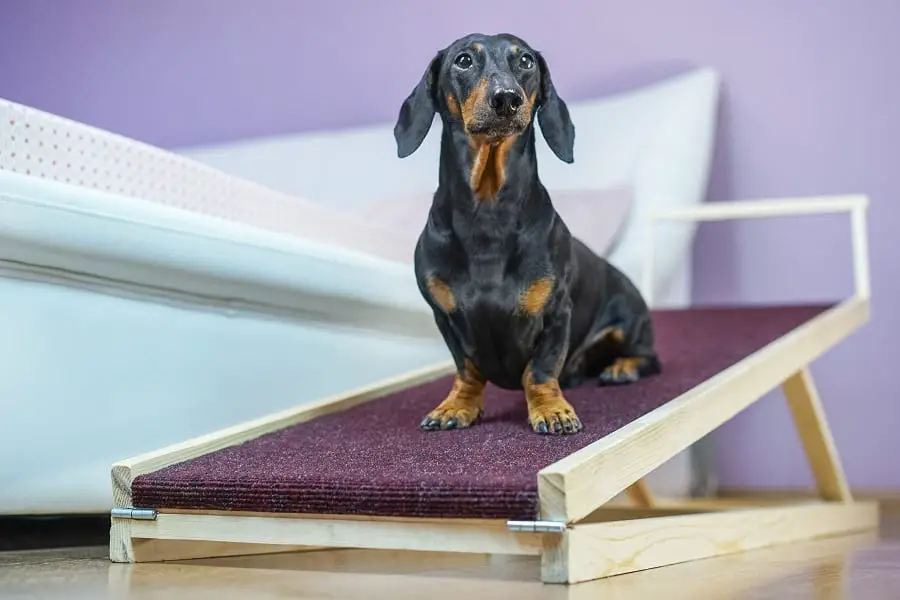
If your dachshund is used to using the stairs, you may have to spend a little time teaching him to use ramps instead.
Most ramps can be adjusted for the steepness of the incline.
If it’s practical, put the ramp flat on the ground, either outside on the lawn or inside on the carpet, and make sure it’s stable and doesn’t wobble or slide.
Encourage your doxie to get on the ramp by placing treats at the beginning, middle, and end of the ramp.
If your dachshund jumps off the ramp, put him back on and give him a treat and praise if he stays on.
When your doxie has mastered walking on the ramp to get to the treats, remove them but keep a treat in your hand.
Lure your dachshund up and down the ramp by letting him follow the treat in your hand. Whenever your doxie reaches the top or the bottom of the ramp, give him the treat.
The next step is to stop giving your doxie a treat every time he successfully negotiates the ramp; let him follow your empty hand every now and then.
Gradually decrease the treats until your dachshund follows your empty hand up and down the ramp without hesitation.
Gradually raise the incline. Some doxies panic and jump off the ramp if it’s too high all at once.
When your dachshund is cocky and confident moving up and down the inclined ramp without treats, put the ramp in its permanent place next to the stairs.
Your doxie should have no hesitation using the ramp now, but if he does, offer a few treats as an encouragement.
You don’t need to train your doxie on different ramps; once he uses one ramp with confidence, he’ll have no problem using any others around the house and yard.
Other Things You Can Do to Prevent Spinal Injuries
Slim and trim dachshunds are healthy dachshunds.
Even if your doxie uses ramps, and never climbs up and down stairs, being overweight or obese also carries a high risk of developing IVDD.
Every extra one pound of weight your dachshund carries puts four pounds of stress on the back and spine.
We all know that a healthy diet and regular exercise is the miracle cure for being overweight or obese.
Also, regular exercise will strengthen your doxie’s back and spine, giving IVDD less of a chance to take hold.
Put your doxie on a vet-approved kibble or food plan and go for a daily walk.
Also, using a harness instead of a collar, picking your doxie up with both hands and never letting the back legs dangle, and giving him a fish oil supplement, will all help to maintain a healthy spine and keep those discs soft and jelly-like.
Precautions
IVDD is a horrible condition.
While treatment, both non-surgical and surgical, is reasonably successful, our hearts will break for the pain and long recovery period our doxies will endure if they get it.
Much better to do what we can to prevent our dachshunds from developing IVDD in the first place.
The dachshund’s body shape is what makes them prone to spinal injury and IVDD. We can’t change that, and we wouldn’t want to; it’s what makes them so cute, after all.
But we can prevent our doxies from developing IVDD by taking a few precautions: ramps instead of stairs, a healthy diet, and regular exercise.
